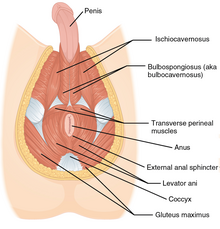Radical retropubic prostatectomy


| Radical retropubic prostatectomy | |
|---|---|
| ICD-9-CM | 60.4, 60.5 |
Radical retropubic prostatectomy is a
Description
Radical retropubic prostatectomy was developed in 1945 by Terence Millin at the All Saints Hospital in London. The procedure was brought to the United States by one of Millin's students, Samuel Kenneth Bacon, M.D., adjunct professor of surgery,
The prostate is removed from the urethra below and the bladder above, and the bladder and urethra are reconnected. The blood vessels leading to and from the prostate are divided and tied off. Recovery typically is rapid; individuals are usually able to walk and eat within 24 hours after surgery. A
- lymph nodes in the early stages, especially the sentinel lymph node. Removal of select lymph nodes in the pelvis allows microscopic evaluation for evidence of cancer within these nodes. A complication called lymphocelemay occur from drainage of the lymphatic fluid, especially if more pelvic lymph nodes are removed. If cancer is found in the lymph nodes, different therapies may be offered.
- cavernous nerves of penis, which control erection. These nerves are very thin and fragile and run next to the prostate and may be destroyed during surgery, leading to impotence. If the cancer is clinically unlikely to have spread beyond the prostate, nerve-sparing surgery should be offered to minimize impotency and to speed up urinary control.[citation needed]
An intraoperative electrical stimulation
Indications
Radical retropubic prostatectomy is typically performed in men who have early stage prostate cancer. Early stage prostate cancer is confined to the prostate gland and has not yet spread beyond the prostate or to other parts of the body. Attempts are made prior to surgery, through
Complications
The most common serious complications of radical retropubic prostatectomy are loss of urinary control and impotence. As many as 40% of men undergoing prostatectomy may be left with some degree of urinary incontinence, usually in the form of leakage with sneezing, etc. (stress incontinence) but this is highly surgeon-dependent. Continence and potency may improve depending on the amount of trauma and the patient's age at the time of the procedure, but progress is frequently slow. Doctors usually allow up to 1 year for recovery between offering medical or surgical treatment. Potency is greatly affected by the psychological attitude of the patient.[citation needed]
- penile plethysmograph.[4]The results aid in managing additional therapeutic options earlier.
- Stress incontinence after prostatectomy can be secondary to the damage sustained by the urethral sphincter, leading for its incomplete closure. Increase in intra-abdominal pressure, like when a person sneezes, coughs, or laughs, may lead to urine leakage.[5] Several treatments are available to treat post-prostatectomy incontinence. Conservative therapy includes Kegel exercises, lifestyle changes, bladder training, using absorbent pads, penile clamps, and other simple measures. If conservative treatment fails, patients can be offered surgical treatment. Surgery includes the insertion of male urethral slings or an artificial urinary sphincter. Artificial urinary sphincters are the gold standard of care in moderate to severe post-prostatectomy incontinence.[6]
Even though the complications of prostate surgery can be bothersome, treatments are available, and patients should seek guidance from their physician instead of ignoring the problem.
References
- ^ "Patrick C. Walsh, M.D." urology.jhu.edu. Retrieved 18 June 2019.
- ^ Radical retropubic prostatectomy
- ^ "Erectile Dysfunction After Prostate Cancer". www.hopkinsmedicine.org. 19 November 2019. Retrieved 2020-04-01.
- ^ Kolotz, L, et al. A Randomized Phase 3 Study Of Intraoperative Cavernous Nerve Stimulation with Penile Tumescence Monitoring to Improve Nerve Sparing During Radical Prostatectomy. Journal of Urology 2000;164(5):1573–1578.[1]
- PMID 26328137.
- ^ F.C. Burkhard (Chair), J.L.H.R. Bosch, F. Cruz, G.E. Lemack, A.K. Nambiar, N. Thiruchelvam, A. Tubaro Guidelines Associates: D. Ambühl, D.A. Bedretdinova, F. Farag, R. Lombardo, M.P. Schneider (2018). "EAU Guidelines on Urinary Incontinence in Adults" (PDF). European Association of Urology. Archived from the original (PDF) on 2020-02-08. Retrieved 2020-03-28.
{{cite journal}}: CS1 maint: multiple names: authors list (link)
- Klein, EA, Jhaveri, F, Licht, M. Contemporary technique of radical prostatectomy. In: Management of Prostate Cancer, Klein, EA (Ed), Humana Press, New Jersey, 2000
- Millin T. Retropubic prostatectomy a new extravesical technique report, The Lancet 1945, Volume 246, Issue 6379, Pages 693–696.
- Walsh PC, Donker PJ. Impotence following radical prostatectomy: insight into etiology and prevention. J Urol 1982;128(3):492–497.
